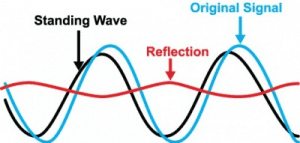Constellation diagrams are 2D graphical representations of digitally modulated signals. They are used for the display and analysis of digitally modulated waveforms, and provide valuable insight into the performance of a digital communication system.
Digitally modulated signals encode information within a sinusoidal carrier wave by mixing it with a discretized message signal, therefore modifying the amplitude and/or phase angle of the carrier’s waveform. The resulting modulated signal has a finite combination of amplitude and phase values, which correspond to a finite number of symbols which can be used to convey information. These symbols are often represented in polar format on the complex plane in what is known as a “constellation diagram” with each possible symbol mapped as a “constellation point”. The location of each point on the diagram is determined by the amplitude and phase angle associated with its corresponding symbol.
The exact number of symbols (i.e. constellation points) in a modulation scheme’s digitized “alphabet” is dependent upon the type of modulation scheme used. The amount of information that can be transmitted with a single symbol increases with the size of a modulation scheme’s alphabet. For example, binary phase-shift keying (BPSK) has just two possible symbols and can therefore transmit just one bit per symbol: 0 or 1. On the other hand, quadrature phase-shift keying (QPSK) has four possible symbols and can therefore transmit two bits per symbol: 00, 01, 10, or 11. Other modulation schemes, such as quadrature amplitude modulation (QAM) can have, in practice, as many as 256 possible symbols. As a result, each modulation scheme has its own unique constellation diagram (Fig. 1).

In theory, each constellation point has an exact amplitude and phase value associated with it, pinpointing its unique location on the constellation diagram. In practice, magnitude and phase errors are introduced by spurious signals, distortion, and other sources of noise in the system. When analyzing a digital signal, the measured values of each received symbol are plotted against the ideal constellation diagram of the modulation scheme in question. A signal with minimal distortion will have its received symbols tightly clustered around their ideal constellation point locations. As the signal becomes increasingly distorted, the clusters of measured values will spread further from their ideal locations on the diagram as magnitude and/or phase errors become greater.
A good example of this is given in Fig. 2, where the input drive level of a signal modulated using 64QAM is increased from -30 dBm to 0 dBm. The 64 white circles represent the ideal magnitude and phase for each of the 64 symbols used in 64QAM. The red dots represent the measured signal’s magnitude and phase for each of the 64 symbols.

NuWaves Engineering has developed a wide variety of off-the-shelf RF power amplifiers with rich features to support mission-critical CONOPS in telemetry, ISR, and tactical communication systems applications. Frequency ranges are available from UHF through C-band with output power levels ranging from 5 to 100 W. All NuPower PAs are designed, built and tested in-house under NuWaves’ Quality Management System (QMS) certified to AS9100:2009 and ISO 9001-2008 standards, which ensures that each product arrives on-time and defect-free. Most models are in-stock. NuWaves also boasts a full suite of state-of-the-art design and simulation tools, test and measurement equipment, prototyping equipment and a full-scale production facility to provide custom solutions to your specifications. Contact NuWaves today to find out how our products can help to mitigate signal distortion in your digital communication systems.


